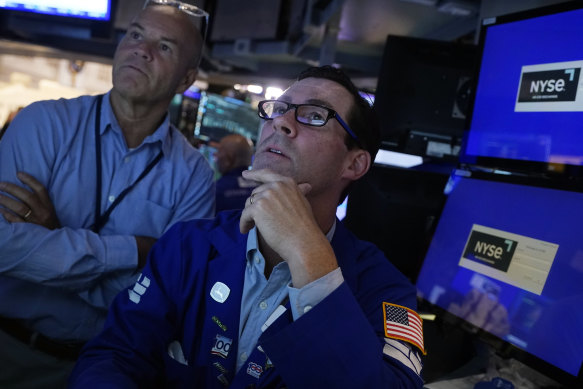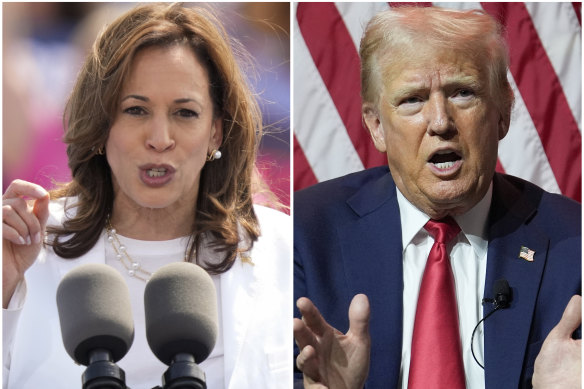
“We do not seek or welcome further cooling in labour market conditions,” he said.
“The direction of travel is clear, and the timing and pace of rate cuts will depend on incoming data, the evolving outlook and the balance of risks.”

Wall Street jumped after Powell’s speech.Credit: AP
He didn’t use the term “soft landing” but did say that with “the appropriate dialling back of policy restraint” there was good reason to think the Fed could get back to two per cent inflation while maintaining a strong jobs market.
The problem with being dependent on data, as central bankers tend to be, is that the data reflects the past and, as the US payroll data demonstrated, isn’t always reliable.
That raises the question of whether the Fed has left rates too high for too long and whether its rate decisions over the remainder of this year will be sufficient to avoid an otherwise avoidable hard landing for the US economy.
Powell was signalling very clearly that there will be the first rate cut in a new interest rate cycle at the next meeting of the Open Market Committee in the middle of next month.
On its past form, the Fed will probably cut rates by 25 basis points (or a quarter of a percentage point) and then move cautiously unless the data it relies on forces its hand.
The markets are pricing in something more aggressive.
While there does seem to be an expectation that the first cut will be 25 basis points, a full percentage point of rate reductions is priced in before the end of the year. That implies at least one “jumbo” 50 basis point rate cut and another 25 basis point move at one of the September, November or December meetings.
Loading
That would prompt howls of outrage from Donald Trump, and probably threats from him to Powell’s position and the Fed’s future independence given that two of those meetings will occur in the lead-up to the US elections.
The Fed insists its decisions are made without regard to their political implications, but by starting the rate-cutting process so close to the election its actions will have political implications.
Before next month’s meeting, the Fed will see the August reading for its preferred measure of inflation, the personal consumption expenditures index on August 30 and, early next month, more jobs data. Regardless of their reliability, the data will inevitably – because central banks tend to be reactive rather than proactive – guide their decision-making.
Whatever the pace and scale of the Fed’s rate cuts, they are coming. The US will be joining a roughly synchronised shift by the major central banks, excluding Japan, towards subsidence of the decades-high rates in response to decades-high inflation rates ignited by the post-pandemic supply shocks and exacerbated by the fiscal largesse of governments’ responses.
Already, central banks in Europe, Britain, Canada and China have begun retracing the paths of the surges in their post-pandemic interest rates.

The rate cuts are set to kick off with the election cycle in full swing.Credit: AP
When the world’s most influential central bank joins them, it will represent an unusual uniformity of major central bank strategies, taking pressure off other central banks (including the Reserve Bank) to maintain existing interest rate relativities with the US to protect their currencies. Their broadly similar policy directions will also provide a wide base of support for the global economy.
That’s provided, of course, that the shifts in strategies aren’t too little, too late.
With hindsight, the Fed probably should have started to cut its rates at the July meeting, if not earlier, given that there are considerable lags between what it does and the impacts of those actions on the real economy.
Financial markets, of course, are forward-looking and that helps explain why the sharemarket has been buoyant in recent weeks, and why the yields on US government bonds have tumbled over the past month.
A month ago, the yield on two-year US Treasury notes was 4.43 per cent. It’s now 3.92 per cent. The yield on 10-year bonds was 4.24 per cent. It is now 3.8 per cent.
The problem with being dependent on data, as central bankers tend to be, is that the data reflects the past and, as the US payroll data demonstrated, isn’t always reliable.
While the much-sought-after soft landing and the avoidance of a recession remains attainable – the US has rarely achieved one coming out of a period of elevated inflation – the Fed isn’t hiding from the reality that it hasn’t handled this episode as well as it might have.
It was slow to react to the emergence of rising inflation, believing it was transitory (as did most central bankers and external economic analysts) and history might determine that it has been too slow to respond to the subsidence of inflation.
Later this year the Fed will start the process for a review of its actions over the four years since its last strategic review in 2020.
Loading
This will essentially be a post-mortem of the strategies, monetary policy tools and communications strategies it deployed over the intervening years; years that included the pandemic, the post-pandemic supply chain shocks and the wars in Ukraine and the Middle East.
Given the novelty and challenges of those circumstances, it will be fascinating to see what the review concludes. One could query whether any changes to them will be of any relevance when the Fed, or some of its peers (like the RBA) that have already experienced and acted on their own reviews, confront another novel challenge in future.









 Add Category
Add Category